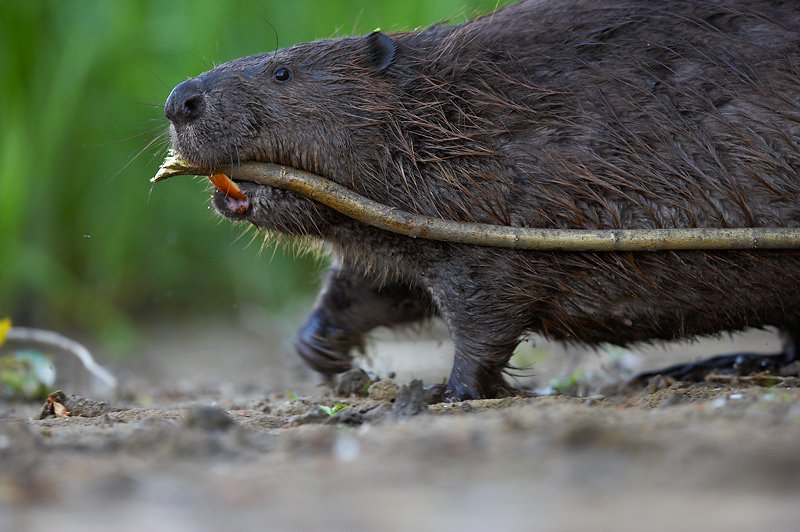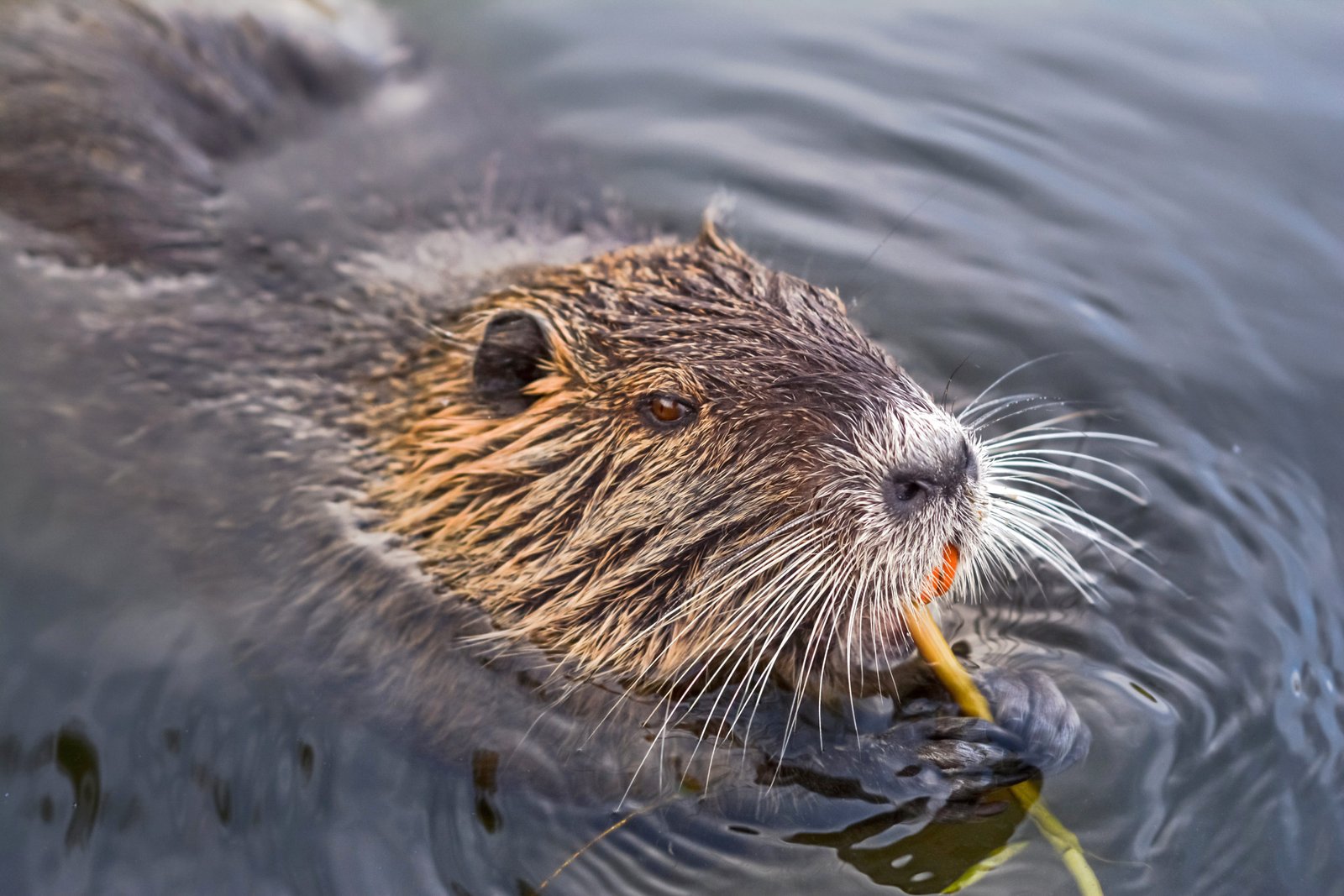Eurasian Beaver: Castor Fiber

Description Of The Eurasian Beaver
There is minimal sexual dimorphism in Eurasian Beavers; the average male weighs approximately 22 kg and is 0.9 m long. On average, females weigh 23 kg and are 1 m long (females tend to be larger than males).
Beavers have stocky bodies referred to as scoops with flattened hairless tails. They have swimming membranes between their toes, hands, and both forelegs. The Eurasian beaver has very prominent incisors.
It has a thick coat of fuzzy, straight hair, ranging on the upper parts from a rich glossy brown to a yellowish-brown, and the underparts from brown to tawny. Its small eyes have nictitating membranes, and it has valvular ears and nostrils. 1Go To Source borealforest.org -“Castor fiber Eurasian Beaver”
Learn More: Types Of Beavers
Eurasian Beaver Behavior

Eurasian beavers, although they may also be active during the day, are primarily nocturnal. Usually, their dens are burrows on the bank of a river or pond. They build lodges out of sticks and mud away from the shore in locations where the bank is not suitable.
Beavers in the lodges live in colonies of up to 12. Only one dominant, monogamous breeding pair is found within a single colony. The dominant female of the colony will determine when young are allowed to travel outside the den.
When it is time for the young to travel outside the den for the first time and when the young need to disperse, the dominant female decides.
Beavers are semi-aquatic and may stay for 4 to 5 minutes at a time underwater. They are active throughout the year but hardly ever arriving in their northernmost regions above the ice surface during the winter months. For this reason, to last them through the winter, beavers spend the autumn season building food caches in the water. Food caches, like willow and aspen branches, consist of woody vegetation.
Beavers are a keystone species that can alter a watershed’s flow and nutrient cycling by building dams to control water depth. However, Eurasian beavers don’t require as extensive dens as their cousins from North America, usually building much smaller dams and lodges.
Eurasian beavers are very territorial, marking their territory with a form of olfactory communication called castoreum. This is accomplished by constructing a scent mound on the shore. They carry mud and vegetation up from the bottom, hold it with their forelegs tightly to their chest, and push themselves with their hind legs up the bank until they have a mound. The beaver will then apply castoreum to the pile of mud, creating a mound of fragrance. In their territory, beavers act very aggressively towards an unidentified scent mound, often hisses at it, slaps the water with the tail, and immediately resurfaces. They will most often create a perfume mound next to it or on top of it.
Eurasian beavers must regularly groom themselves to maintain their water-repelling fur. This beaver will use their toenails to remove oils from their fur and oil glands. This oil on the outside of the beaver fur prevents water from reaching the beaver’s skin. Beavers would become wet to the skin without these oils and wouldn’t be able to withstand the cold temperatures of the water they live in. 2Go To Source animaldiversity.org -“Castor fiber Eurasian beaver”
Reproduction Cycle Of Eurasian Beavers
From December to April, monogamous breeding takes place. Pregnancy is 103-108 days in duration. Between May and June, the litter size is 1-6 young. At the age of 2 years, individuals are sexually mature but unlikely to breed successfully until they reach the age of 3 years.
Eurasian Beaver Habitat
The Eurasian beaver’s preferred habitat is on riverbanks in dense forests. Avid swimmers and scuba divers live half their lives in the water and half their lives on land. They tend to be somewhat nocturnal, coming to feed on twigs, bark, and river vegetation from their cave homes at night.
Busy builders also never eat the same kind of trees they use to build dams and lodges. The beaver is protected from predators by these dams and lodges.
Range Of Eurasian Beavers

The species is native to Belarus, China, France, Germany, Kazakhstan, Luxembourg, Mongolia, Norway, and the Russian Federation.
In the following countries, the species has been reintroduced by humans: Austria; Belgium; Croatia; Czech Republic; Denmark; Estonia; Finland; Hungary; Italy; Latvia; Liechtenstein; Lithuania; Montenegro; Netherlands; Poland; Romania; Serbia; Slovakia; Slovenia; Spain; Sweden; Switzerland and Ukraine.
Eurasian Beaver Diet
The Eurasian beaver is an herbivorous animal (folivorous and lignivorous). Their diet primarily consists of woody vegetation such as aspen trees, birch trees, or willows during the winter. However, these rodents consume aquatic plants, bark, leaves, roots, buds, twigs, shoots, and crops in agricultural areas in the summer months. 3Go To Source animalia.bio -“EURASIAN BEAVER”
Predators Of Eurasian Beaver
Across Europe, red foxes, lynxes, and Eurasian wolves are the main predators of Eurasian beavers. Beavers found in great Britain are mostly protected from predation. However, in some habitats, they may be vulnerable to disturbance from humans and dogs, particularly during spring breeding.
The primary threat to Eurasian beavers has historically been humans. Beavers have largely disappeared from Britain because of over-hunting. They hunted beavers for their rich, lustrous fur, which was often turned into hats. 4Go To Source discoverwildlife.com -“Eurasian beaver guide: how to identify, why they became extinct in the UK, and where they’ve been reintroduced”
Eurasian Beaver Conservation
Once widespread in Great Britain and Europe, the Eurasian beaver was hunted across its range for its fur and its musk-scented secretions, called castoreum. By the 16th century, it was extinct in Britain, and in 1900, the Eurasian population was only 1,200 beavers. Successful reintroduction efforts have increased populations in Scotland, France, Germany, and Austria.
The Eurasian beaver is now formally recognized as a native species in Scotland following a reintroduction project. They were extinct in Scotland for over 400 years before this and longer in England and Wales, where there are still no recognized populations. In Scotland, the existing small population consists of individuals introduced from Norway. 5Go To Source ptes.org -“Eurasian beaver”
Sources:
- “Boreal Forests of the World Mammal Species – Eurasian Beaver.” Boreal Forest, www.borealforest.org/world/mammals/eurasian_beaver.htm. Accessed 28 Jan. 2021.
- Holden, J. 2009. “Castor fiber” (On-line), Animal Diversity Web. Accessed January 28, 2021 at https://animaldiversity.org/accounts/Castor_fiber/
- “Eurasian Beaver – Facts, Diet, Habitat & Pictures on Animalia.Bio.” Animalia, Animalia, animalia.bio/eurasian-beaver. Accessed 28 Jan. 2021.
- Trust, Beaver. “Eurasian Beaver Guide: How to Identify, Why They Became Extinct in the UK, and Where They’ve Been Reintroduced.” Discover Wildlife, Immediate Media Company Ltd, www.discoverwildlife.com/animal-facts/mammals/facts-about-eurasian-beavers/#:%7E:text=Across%20Europe%20the%20main%20predators,are%20largely%20protected%20from%20predation. Accessed 28 Jan. 2021.
- “Eurasian Beaver – People’s Trust for Endangered Species.” People’s Trust for Endangered Species, People’s Trust for Endangered Species, ptes.org/get-informed/facts-figures/eurasian-beaver. Accessed 28 Jan. 2021.
